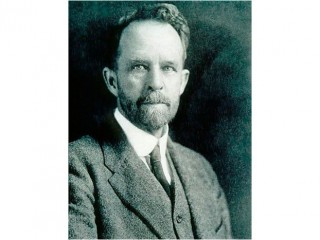
Thomas H. Morgan biography
Date of birth : 1866-09-25
Date of death : 1945-12-04
Birthplace : Lexington, Kentucky,U.S.
Nationality : American
Category : Science and Technology
Last modified : 2011-12-17
Credited as : scientist, Fruit fly chromosomes and heredity, Nobel laureate
2 votes so far
In his early career, zoologist and geneticist Thomas H Morgan argued against Charles Darwin's theory of natural selection, and published a paper arguing that specific hereditary traits could not be carried on a single chromosome. He changed his mind when he began studying inherited traits among the small fruit fly Drosophila melanogaster. Breeding the bugs by the millions in his "fly room" at Columbia University, he kept detailed files on their physical similarities, differences, and mutations.
From these patterns, he theorized a linear arrangement of genes in the fruit flies' chromosomes, and surmised in his famous book Mechanism of Mendelian Heredity that chromosomes are responsible for identifiable, hereditary traits. His work helped clarify the mysteries of evolution, formed the modern understanding of heredity, and won Morgan the 1933 Nobel Prize in Physiology or Medicine.
He married Lilian Vaughan Sampson, a pioneering geneticist in her own right. She authored sixteen scientific papers and discovered the attached X and closed X chromosomes in fruit flies.
Morgan's maternal great-grandfather was Francis Scott Key, author of "The Star-Spangled Banner". On his father's side, his uncle, John Hunt Morgan, was a Confederate General in the Civil War, and the namesake of Morgan's Raid, where, in 1863, he led the South's farthest incursion into the North, into Kentucky, Indiana, and Ohio. His great-grandfather was Charlton Hunt, the first Mayor of Lexington, and his great-great-grandfather was John Wesley Hunt, one of that city's founders.
In 1894 Morgan was granted a year's absence to conduct research in the laboratories of Stazione Zoologica in Naples, where Wilson had worked two years earlier. There he worked with German biologist Hans Driesch, whose research in the experimental study of development piqued Morgan's interest. Among other projects that year, Morgan completed an experimental study of ctenophore embryology. In Naples and through Loeb, he became familiar with the Entwicklungsmechanik (roughly, "developmental mechanics") school of experimental biology. It was a reaction to the vitalistic Naturphilosophie, which was extremely influential in 19th century morphology. Morgan changed his work from traditional, largely descriptive morphology to an experimental embryology that sought physical and chemical explanations for organismal development.
When Morgan took the professorship in experimental zoology, he became increasingly focused on the mechanisms of heredity and evolution. He had published Evolution and Adaptation (1903); like many biologists at the time, he saw evidence for biological evolution (as in the common descent of similar species) but rejected Darwin's proposed mechanism of natural selection acting on small, constantly-produced variations.
In 1915 Morgan, Sturtevant, Calvin Bridges and H. J. Muller wrote the seminal book The Mechanism of Mendelian Heredity. Geneticist Curt Stern called the book "the fundamental textbook of the new genetics" and C. H. Waddington noted that "Morgan's theory of the chromosome represents a great leap of imagination comparable with Galileo or Newton".
Morgan left an important legacy in genetics. Some of Morgan's students from Columbia and Caltech went on to win their own Nobel Prizes, including George Wells Beadle and Hermann Joseph Muller. Nobel prize winner Eric Kandel has written of Morgan, "Much as Darwin's insights into the evolution of animal species first gave coherence to nineteenth-century biology as a descriptive science, Morgan's findings about genes and their location on chromosomes helped transform biology into an experimental science."
Legacy and honors:
-Johns Hopkins awarded Morgan an honorary LL.D. and the University of Kentucky awarded him an honorary Ph.D.
-He was elected a member of the National Academy of Sciences and made a foreign member of the Royal Society.
-In 1924 Morgan received the Darwin Medal.
-The Thomas Hunt Morgan School of Biological Sciences at the University of Kentucky is named for him.
-The Genetics Society of America annually awards the Thomas Hunt Morgan Medal, named in his honor, to one of its members who has made a significant contribution to the science of genetics.
- Thomas Hunt Morgan's discovery was illustrated on a 1989 stamp issued in Sweden, showing the discoveries of eight Nobel Prize-winning geneticists.
-A junior high school in Shoreline, Washington was named in Morgan's honor for the latter half of the 20th century.
















